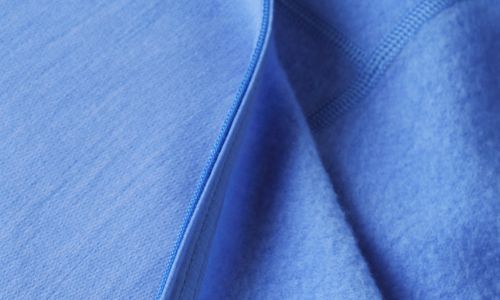Merino wool vs cotton and other fabrics
10 October 2024
Modern clothing can be made out of many different fabrics, including natural as well as synthetic materials. It's important to choose the right fabric to fit your clothing requirements, whether you'd like it to help keep you warm, keep you cool, or offer breathability and comfort all year round.
Many people think of wool as only suitable for hats, scarves and jumpers in the winter time. But lightweight, breathable merino wool is different. It's a firm favourite for activewear, base layers and outer layers as it offers exceptional softness, thermoregulation and moisture management properties to keep you dry. In this article we'll look at how merino compares to other fabrics, to help you select the best material for your needs, and consider how merino's versatility and resilience accounts for its continued popularity when it comes to clothing and accessories.
Merino wool vs cotton
The first difference between merino wool and cotton is that merino comes from a sheep's fleece - specifically the merino that is native to New Zealand - and cotton comes from a plant, grown throughout America, the Middle East and Asia. But when considering merino wool vs cotton, both materials have their benefits:
•Both cotton and merino are lightweight, and offer breathability and comfort in warm climates, but merino wins when it comes to overall warmth.
•Merino's fleece efficiently traps air, offering outstanding thermoregulation to adapt to your body temperature, and it even stays warm when wet.
•Merino's resilient fibres are also very strong, and can stretch to over 30% without breaking.
Depending on how they're woven, both fabrics offer:
•Softness and next-to-skin comfort as well as natural odour resistance. But one of the many benefits of merino is that it is versatile enough to be worn all year round, thanks to its exceptional moisture management and insulative abilities.
•Cotton is usually more readily available in shops, as it's produced in many more countries and in much higher yields than merino. This often means that it is cheaper to buy, but it can vary significantly in quality.
•Cotton may also be considered easier to clean as it's frequently tumble-dryer safe, but caring for merino wool icebreaker clothing is straightforward too, as it can usually be washed in the machine and dried naturally. Cotton is known to crease more readily, whereas merino's stretchy fibres spring back into shape when following the garment's care label.
•Both bamboo and merino wool fabric are soft against the skin and offer exceptional breathability.
•Bamboo is more readily available, and grown across Asia, America and Africa. Its fast-growing nature means it can sometimes be more affordable than natural merino.
•Merino wool is known to be warmer in colder climates, as the natural fibres trap air very effectively, making it suitable for all seasons.
•Merino is naturally odour resistant, which may mean less frequent washing than bamboo after wearing in warm weather.
•One of the biggest benefits of bamboo is that it's considered sustainable and eco-friendly, which is why it's important to choose merino clothing from a manufacturer who demonstrates a clear commitment to animal welfare standards - such as icebreaker's 5 freedoms of our flock.
•Bamboo is strong and easy to care for, and merino wool is also designed to be resilient even after washing and in challenging outdoor conditions.
•Warmth, softness and breathability. Alpaca and merino wool are both known to be soft against the skin, but merino wool fibres are finer than standard sheep's wool, and can be several microns thinner than alpaca wool to ensure clothing doesn't itch your skin.
•Both merino and alpaca wool provide excellent thermoregulation and moisture management, keeping you warm in winter and cool in summer.
•Alpaca wool is considered stronger, but merino can also be highly resilient.
•Both wool types may be able to be machine washed, but to maintain performance always wash on a cool, gentle cycle as per the care label.
•Merino wool is generally less expensive than alpaca wool, which is considered more of a luxury item as alpaca wool can be more difficult to source.
•Geelong is a more exclusive, less readily available wool as it comes from the first clippings of a pedigree merino sheep in a specific area of Australia, so it comes with a higher price tag to match.
•Geelong, a fine merino wool, shares similar breathability, moisture managing, natural odour control and thermoregulating properties. It is also strong, lightweight and resilient.
•With its ultra fine fibres, geelong is extremely soft, non-itchy and warm, making it ideal for luxurious knitwear. However, it can be more sensitive to heat and friction than other merino wool, making it trickier to care for.
•Geelong is not always machine washable, unlike icebreaker merino clothing, making care and maintenance more time consuming.
•Mohair is marketed as a luxury item, and is more expensive than sheep's wool because it's considered rarer, with a complex production process.
•Mohair is considered stronger than merino wool overall, but merino is also resilient for many different clothing types.
•Mohair and merino are both breathable, naturally manage moisture, help to regulate temperature, offer natural odour resistance and are soft against the skin.
•Merino is easier to care for and can usually be machine washed, unlike mohair which can be trickier to care for. This makes merino more suitable for lightweight activewear and high-performance activity clothing.
•Polyester is not breathable, unlike merino, and doesn't allow air to circulate. This makes it less suitable for active wear, underwear or base layers. Unlike merino, it can smell after use as it's not naturally odour resistant.
•Merino manages moisture effectively and adapts to your body temperature, as part of its thermoregulating properties, unlike synthetic polyester.
•Polyester is extremely strong and durable, but can feel scratchy and more uncomfortable against the skin when compared to softer merino fibres.
•Being artificially made, polyester is cheaper and more readily available than merino, but is considered more harmful to the environment as it's not biodegradable, and many 'fast fashion' polyester items end up in landfill.
•Polyester is highly flammable, whereas merino is naturally less flammable.
•Merino's breathability makes it ideal for different seasons, as well as for comfortable base layers as well as outer layers. It stays warm when wet, unlike polyester, making it ideal for different conditions.
•Although the fibres are very strong, silk is not as resilient as merino wool when it comes to resisting heat and moisture. It is more prone to damage from the elements than natural merino fibres.
•Silk is luxuriously soft and feels very comfortable against the skin, however it doesn't have the same thermoregulating properties of merino, and therefore is not considered as breathable in warm conditions.
•Unlike merino, silk doesn't offer the same natural odour resistance as wool can, meaning you may need to wash it more frequently.
•When it comes to washing, silk is more difficult to look after as it can become damaged in the wash. It usually requires hand washing using specific silk-friendly detergents.
•Silk is more expensive than merino, due to the small amounts produced and the complex method of weaving it into fabric.
It's possible to blend merino wool with cotton, for an amazing natural fibre combination which is soft and breathable, making it ideal for everyday wear. At icebreaker, we're dedicated to becoming plastic-free by moving away from synthetic fibres. Our cotton is organically grown, and can be the perfect partner to merino fibres for various types of clothing.
Bamboo vs merino wool
When it comes to bamboo vs merino wool, it's worth considering the pros and cons of each, depending on how you want your clothing to perform.
At icebreaker, we use another special plant-based fibre - TENCEL™ Lyocell - to blend with merino fibres. Also considered an eco-friendly fabric, similar to bamboo, it's exceptionally gentle on your skin and blends beautifully with merino wool as part of our innovative Cool-Lite™.

Alpaca vs merino wool
Merino is one of many different natural wool types, so when looking at alpaca vs merino wool they share some common benefits, even though they come from different animal species - the merino being a sheep and the alpaca belonging to the camelid family. When comparing merino wool vs wool types from other animals, such as alpaca, both offer:
Geelong wool vs merino wool
Geelong wool is considered a luxury lambswool from a special breed of merino sheep native to the city in Melbourne, Australia, where the fabric originally came from. Geelong wool vs merino share lots of similarities, as they both come from merino sheep, but geelong is thought of as more akin to cashmere when it comes to warmth and opulence.
Merino wool vs mohair
Mohair comes from angora goats, traditionally from Tibet, and is commonly used for luxurious sweaters, scarves and warm winter accessories.
Merino wool vs polyester
Polyester, also known as polyethylene terephthalate, is a popular synthetic material used for clothing. It is cheaper than merino, but this man-made fabric has very different properties.
icebreaker are committed to removing unnecessary plastic from our performance apparel, as part of our dedication to nature-led innovations, deepening ties with our growers, and evolving with unfiltered transparency. Today, we use 96.14% plastic-free fibres in our products.
Merino wool vs silk
Silk, which was traditionally produced in China and Persia, is a natural product made by silkworms when they spin their cocoons, producing a highly luxurious fabric. As well as being created by worms as opposed to merino sheep, silk differs to natural wool in several ways:
Merino wool vs cotton - Summary
Although many different natural fabrics also provide warmth, temperature regulation and softness just like merino wool, merino's lightweight nature and adaptability in different temperatures and conditions is what accounts for its continued popularity, offering exceptional performance and versatility. Merino wool, unlike synthetic fibres and some other fabrics, offers excellent natural odour control and stays warm when wet, as well as being softer than traditional wool without feeling itchy on your skin. Shop merino wool today and discover the benefits it can bring when it comes to comfortable, high-end clothing for year-round wear.
Merino wool vs cotton - FAQ
Which is better, merino wool or cotton?
Merino is a high-performance fabric offering outstanding natural odour control, moisture management, temperature regulation and softness, making it ideal for base layers and activewear as it can be worn year-round. Cotton is generally cheaper, and is also breathable and soft, but offers less warmth and temperature control.
Is wool or cotton better for summer?
It may surprise you that merino wool, unlike traditional wool, is ideal for summer clothing! It helps keep you cool and dry by managing moisture and releasing sweat back into the air. Cotton is also cool and breathable, but creases more readily and doesn't offer the same natural odour resistance.
What is more breathable, wool or bamboo?
When considering bamboo vs merino wool, both are breathable but most people consider merino wool as having the edge when it comes to breathability and thermoregulation. Merino fibres trap air to keep you warm in the cold, and absorb and release moisture to keep you cool and dry in the heat.
Is polyester better than merino wool?
Polyester is cheaper, more readily available and highly durable, but its fabric is entirely different to merino wool. Merino is breathable, naturally odour resistant and manages moisture, meaning less frequent washing. Merino is exceptionally soft and is a naturally biodegradable fabric, unlike polyester.
Which is warmer, merino or silk?
Many people consider merino wool to have more efficient temperature regulating properties than silk, making it warmer overall in colder conditions. Merino also stays warm when wet, meaning you'll stay cosy even when weather conditions change.
What material is better than merino wool?
Although cashmere, silk, mohair and geelong are considered more luxurious fabrics, merino wool is resilient, easy to care for and highly versatile. From summer t-shirts to running gear and kids clothing, merino adapts to your body temperature, is soft on skin and helps to keep you feeling fresh and dry in all seasons.
More for you

What is merino wool
10 December 2024 | icebreaker

How to wash merino wool?
01 October 2024 | icebreaker

Merino wool benefits
29 November 2024 | icebreaker
More for you










